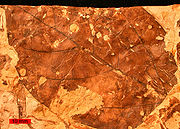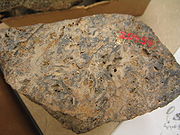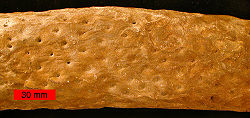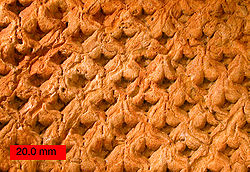Paleobotany
Paleobotany is important in the reconstruction of ancient ecological systems and climate, known as paleoecology and paleoclimatology respectively; and is fundamental to the study of green plant development and evolution. Paleobotany has also become important to the field of archaeology, primarily for the use of phytoliths in relative dating and in paleoethnobotany.
Contents
» Overview of the Paleobotanical Record» Plant fossils
» Kinds of plant fossils
» Form taxa
» Fossil groups of plants
» Notable Paleobotanists
» References
» Further reading
Overview of the Paleobotanical Record
Macroscopic remains of true vascular plants are first found in the fossil record during the Silurian Period of the Paleozoic era.. Some dispersed, fragmentary fossils of disputed affinity, primarily spores and cuticles, have been found in rocks from the Ordovician Period in Oman, and are thought to derive from liverwort- or moss-grade fossil plants (Wellman et al., 2003).The Rhynie Chert is exceptional due to its preservation of several different clades of plants, from mosses and lycopods to more unusual, problematic forms. Many fossil animals, including arthropods and arachnids, are also found in the Rhynie Chert, and it offers a unique window on the history of early terrestrial life.
Plant-derived macrofossils become abundant in the Late Devonian and include tree trunks, fronds, and roots. The earliest tree is Archaeopteris, which bears simple, fern-like leaves spirally arranged on branches atop a conifer-like trunk (Meyer-Berthaud et al., 1999).
Widespread coal swamp deposits across North America and Europe during the Carboniferous Period contain a wealth of fossils containing arborescent lycopods up to 30 meters tall, abundant seed plants, such as conifers and seed ferns, and countless smaller, herbaceous plants.
Angiosperms (flowering plants) evolved during the Mesozoic, and flowering plant pollen and leaves first appear during the Early Cretaceous, approximately 130 million years ago.
Plant fossils
A plant fossil is any preserved part of a plant that has long since died. Such fossils may be prehistoric impressions that are many millions of years old, or bits of charcoal that are only a few hundred years old. Prehistoric plants are various groups of plants that lived before recorded history (before about 3500 BC).Kinds of plant fossils
One of the most common kinds of plant fossils is a compression fossil, in which a leaf or flattened part of the plant has been pressed between layers of sediment and often preserved as a carbonaceous film. Also common are fossil pollen and spores from ancient lake beds, as well as charcoal. Less common, but economically more important, is coal from the plants of Carboniferous swamps.One of the most spectacular of plant fossils is petrified wood.
Form taxa
Fossils of plants are very different from the fossils of animals, and this is in part a result of the different architecture of plants. Animals develop with specific parts, and in both the young and adult animal, those parts exist in fixed numbers and locations. Even animals which undergo metamorphosis have only one head, and will emerge with a fixed body structure.
A fossil Viburnum lesquereuxii leaf with insect damage; Dakota Sandstone (Cretaceous) of Ellsworth County, Kansas. Scale bar is 10 mm.
Since a leaf, stem, spore, or seed may be found preserved without any physical connection to the plant from which it came, paleobotanists use form taxa (singular form taxon) to name and classify such fossils. When the true identity of such fossils is later discovered, the two form taxa may be merged. For example, in the 1960s fossil leaves called Archaeopteris (literally "ancient fern") were found attached to fossil wood of the tree Callixylon. The whole plant is now known to be a Devonian tree with fern-like leaves but with gymnosperm-like wood.
Some form taxa continue to exist even after their identity is determined. This is a matter of convenience for identifying quickly which part was found as a fossil, especially which the fossil may come from more than one kind of plant. Leaves assigned to the form taxon Sphenopteris come from both ferns and from seed plants; it usually is not possible to determine from isolated fossils which group the leaves belong to.
Fossil groups of plants
Some plants have remained remarkedly unchanged throughout earth's geological time scale. Early ferns had developed by the Mississippian, conifers by the Pennsylvanian. Some plants of prehistory are the same ones around today and are thus living fossils, such as Ginkgo biloba and Sciadopitys verticillata. Other plants have changed radically, or have gone extinct entirely.A few examples of prehistoric plants are:
» Araucaria mirabilis
» Archaeopteris
» Calamites
» Cycads
» Glossopteris
» Horsetails
» Hymenaea protera
» Protosalvinia
Notable Paleobotanists
» Kaspar Maria von Sternberg (1761–1838), the "father of paleobotany"» Dunkinfield Henry Scott (1854-1934), analysis of the structures of fossil plants
References
- Brigitte Meyer-Berthaud, S.E. Scheckler, J. Wendt, "Archaeopteris is the Earliest Modern Tree." Nature, 398, 700-701 (22 April 1999)- Charles H. Wellman, Peter L. Osterloff and Uzma Mohiuddin, "Fragments of the Earliest Land Plants." Nature, 425, 282-285 (18 September 2003)
Further reading
- Stewart, W.N. and Rothwell, G.W. 1993. Paleobotany and the evolution of plants, Second edition. Cambridge University Press, Cambridge, UK.- Taylor, T. N. and E. L. Taylor. 1993. The Biology and Evolution of Fossil Plants, Prentice-Hall, Inc., Englewood Cliffs, New Jersey, USA.







